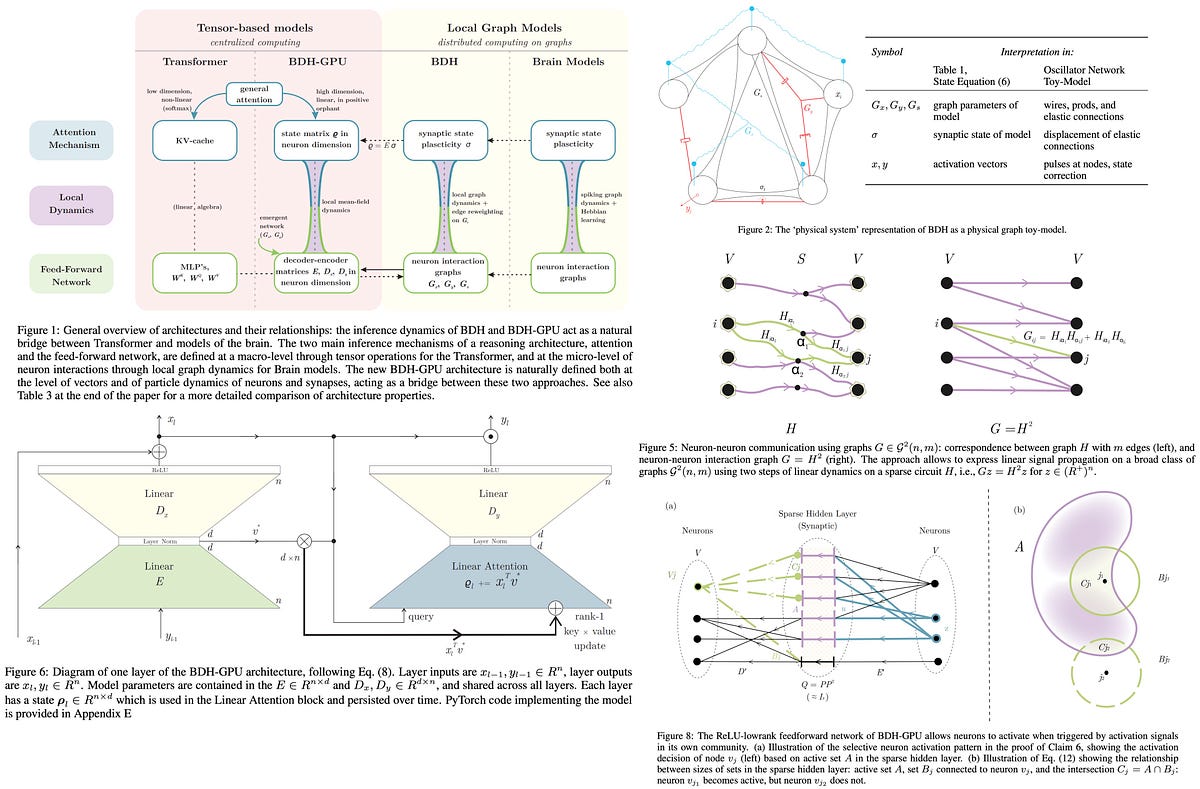Paper Review
The Dragon Hatchling: a biologically inspired LLM that models reasoning as local neuron graph dynamics with Hebbian learning, matching GPT-2 performance while bridging neuroscience and machine learning
Dragon Hatchling (BDH) is a biologically inspired LLM built as a scale-free graph of locally interacting neuron-like units. It uses excitatory and inhibitory circuits with spiking, integrate-and-fire neurons and Hebbian learning to simulate synaptic plasticity, allowing reasoning and memory over hundreds of tokens. BDH matches GPT-2 architecture in performance and scaling behavior while remaining GPU-efficient. Its activations are sparse, positive, and monosemantic, providing inherent interpretability and clear concept representations even in small models. Theoretical analysis links BDH’s attention mechanisms to those observed in the human brain, suggesting a unified set of “equations of reasoning”. This new model offers a framework for understanding large-scale reasoning and aims toward thermodynamic-limit and Probably Approximately Correct (PAC)-like generalization bounds for reasoning over time.
The approach
Formalism for local graph-based language models
The authors describe BDH as a graph-based distributed computing system where computation happens locally at neuron-like nodes, and communication happens along weighted edges connecting them.
The model’s architecture is defined by a scheduler and a local kernel that specify how nodes compute and exchange information over time. Computation and communication occur in alternating sub-rounds, and BDH cycles through four such kernels repeatedly, forming its reasoning dynamics.
In this approach, the graph itself is a program: its topology and edge weights determine how information flows and evolves during reasoning. To formalize this, the authors use ideas from evolutionary dynamics and chemical reaction networks, where entities interact through probabilistic rules that change their states over time.
BDH is defined as an edge-reweighting distributed graph system, where reasoning emerges from local updates of neurons and their synapses according to biologically inspired, mathematically grounded interaction rules.
Interpretation of attention as a micro-inductive bias of reasoning
In BDH, each edge between neurons acts as a micro-program that transforms and passes information. Local rules (like update the connection strength or send activation) define how neurons interact. Together, these rules form a distributed circuit where nodes compute and edges store memory. The system dynamically decides which implications to apply next, guided by which inferences seem most useful or plausible given current context, similar to human reasoning flow.
In this view, attention weights are probabilistic reasoning utilities — they determine which implications the model is likely to follow next, forming chains of thought along active connections. As certain edges become active, they open reasoning pathways through the model’s graph, allowing inference to proceed from source to target concepts.
Expressing BDH using brain models
BDH demonstrates that a brain-like system can perform reasoning and language tasks comparable to Transformer models. The model’s four-step cycle mimics biological processes: neurons fire and compete through excitatory/inhibitory signals, synapses strengthen or weaken through local interactions, and signal transmission adapts over time.
Because BDH achieves Transformer-level performance, this implies that Hebbian learning combined with neural circuitry is both necessary and sufficient for large-scale reasoning and language functions in the brain. In this view, Hebbian learning acts as an unsupervised attention, adjusting synaptic strengths over time to enable thought and inference.
Supervised learning in the brain may then operate by gradually converting short-term synaptic state changes into lasting weight updates at longer timescales. The framework connects cognitive processes occurring over seconds or minutes with their underlying spiking neuron and plasticity dynamics, offering a biologically grounded explanation of how reasoning and learning evolve over multiple temporal layers.
BDH-GPU: a tensor-friendly version of the BDH architecture
BDH-GPU is the tensor-based, GPU-efficient implementation of the BDH architecture. It represents a state-space system defined by three main parameter matrices that evolve through a recurrent update process over time steps (tokens) and layers. Each step updates neuron states, intermediate activations, outputs, and attention-like values, combining local computations and temporal interactions similar to attention mechanisms.
The model processes one token per time step: input tokens are linearly encoded into vectors, passed through several layers following the recurrence, and decoded back into output tokens. It uses a diagonal or block-diagonal matrix for local rotation or damping (analogous to ALiBi or RoPE positional encodings).
Analysis: emergence of modularity and scale-free structure
The ReLU-lowrank block in BDH-GPU replaces the Transformer’s MLP feed-forward layer with a biologically and computationally simpler component that operates entirely in the positive domain.
It uses three matrices to project neuron activations into a lower-dimensional hidden space and back and applies a ReLU gate after the reconstruction. Functionally, a ReLU-lowrank block has expressiveness comparable to a Transformer’s MLP: stacked deeply, it can approximate arbitrary vector functions, though convergence is slower because of the smaller hidden dimension.
Mathematically, the ReLU-lowrank mechanism improves upon plain low-rank mappings by filtering noise. Without ReLU, low-rank approximations distort signals; with ReLU and bias, they can accurately approximate Markov-chain-like propagation on sparse positive vectors while preserving important affinities between nodes.
ReLU acts as a thresholding and denoising step, turning weak or noisy linear activations into clean, interpretable signals.
